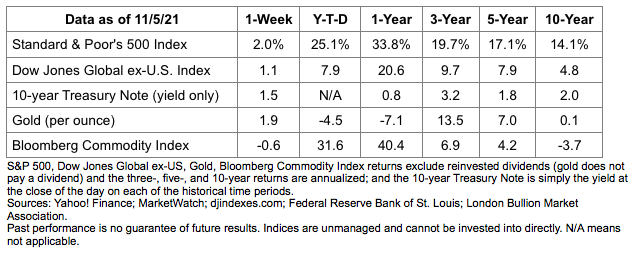Feeling bullish…
Investor bullishness ticked higher last week on all four investor sentiment gauges tracked by Barron’s. Investor optimism may have been fanned by positive financial and economic news. For example, last week:
The jobs report was better than expected. Last week, the Bureau of Labor Statistics (BLS) reported that 531,000 new jobs were added in October, lowering the unemployment rate to 4.6%. In addition, the employment numbers for August and September were better than previously reported. The BLS Employment Diffusion Index measures the breadth of employment gains across the economy. It rose from 63.6 in September to 71.8 in October for private industry, and from 57.3 to 70 in manufacturing. The increase suggests that job gains were spread across diverse industries rather than concentrated in specific ones.
Central banks took a measured approach to policy changes. Investors who were concerned that central banks might pull back stimulus too soon were reassured last week. The U.S. Federal Reserve announced that it will begin tapering its bond buying program, and that the Federal Open Market Committee is not talking about raising rates yet, reported MarketWatch. In addition, the Bank of England surprised investors by not raising rates last week, reported Elliot Smith of CNBC.
Corporate earnings remained strong. Companies’ profits increased during the third quarter. So far, 81% of the companies in the Standard & Poor’s 500 Index have reported a positive earnings surprise, reported John Butters of FactSet. (A positive earnings surprise occurs when earnings are better than analysts expected.) So far, the blended earnings growth rate for the S&P 500 was 39.1 percent in the third quarter.
Major U.S. stock indices finished the week at record highs, again, according to Randall W. Forsyth of Barron’s.9 U.S. Treasuries rallied, too.

Curses often offer explanations for disappointments. The Billy Goat curse on the Chicago Cubs reportedly kept the team from winning a World Series for more than a century. Every actor is wary of the curse of Macbeth, which holds that the play is cursed and brings bad luck to those who perform it.
During the past few years, the term “Infrastructure Week” appeared to be cursed. Every time the White House planned an Infrastructure Week, it was overshadowed by more urgent events, according to Emily Cochrane and Eileen Sullivan of The New York Times. It was concerning because America’s infrastructure isn’t as sound as it once was. The American Society of Civil Engineers (ASCE) has been issuing a Report Card on America’s Infrastructure since 1998, and the best grade earned was a C in 1998.
Last week, the apparent curse was broken when the House of Representatives passed the Infrastructure Investment and Jobs Act (IIJA) with bipartisan support. The bill includes:
-$110 billion to build and repair roads and bridges across the country, fund research and relieve congestion, reported Katie Lobosco and Tami Luhby of CNN.
-$65 billion for power and water system improvements, including building new power lines, expanding renewable energy and upgrading water infrastructure.
-$66 billion for passenger and freight rail systems.
-$65 billion for broadband internet, particularly expanding broadband availability in rural areas and low-income communities.
-$46 billion for flooding, coastal and climate resiliency that helps cities and states prepare for droughts, wildfires, floods and other climate issues, reported the ASCE.
-$42 billion to update ports, waterways and airports.
-$15 billion for electric vehicle charging stations and zero-emission school buses.
The IIJA will be funded by repurposing unspent coronavirus relief money and imposing tax-reporting requirements on cryptocurrencies. The infrastructure bill is expected to increase the deficit – the difference between the amount the United States spends and how much it takes in each year – by $250 to $350 billion over 10 years, depending on who is doing the math.
“…for there is nothing either good or bad, but thinking makes it so…”
—William Shakespeare, playwright
Investment advisory services offered through Keystone Financial Services, an SEC Registered Investment Advisor. These views are those of Carson Coaching, not the presenting Representative, the Representative’s Broker/Dealer, or Registered Investment Advisor, and should not be construed as investment advice. This newsletter was prepared by Carson Coaching. Carson Coaching is not affiliated with the named firm or broker/dealer. Government bonds and Treasury Bills are guaranteed by the U.S. government as to the timely payment of principal and interest and, if held to maturity, offer a fixed rate of return and fixed principal value. However, the value of fund shares is not guaranteed and will fluctuate. Corporate bonds are considered higher risk than government bonds but normally offer a higher yield and are subject to market, interest rate and credit risk as well as additional risks based on the quality of issuer coupon rate, price, yield, maturity, and redemption features. The Standard & Poor’s 500 (S&P 500) is an unmanaged group of securities considered to be representative of the stock market in general. You cannot invest directly in this index. All indexes referenced are unmanaged. The volatility of indexes could be materially different from that of a client’s portfolio. Unmanaged index returns do not reflect fees, expenses, or sales charges. Index performance is not indicative of the performance of any investment. You cannot invest directly in an index. The Dow Jones Global ex-U.S. Index covers approximately 95% of the market capitalization of the 45 developed and emerging countries included in the Index. The 10-year Treasury Note represents debt owed by the United States Treasury to the public. Since the U.S. Government is seen as a risk-free borrower, investors use the 10-year Treasury Note as a benchmark for the long-term bond market. Gold represents the 3:00 p.m. (London time) gold price as reported by the London Bullion Market Association and is expressed in U.S. Dollars per fine troy ounce. The source for gold data is Federal Reserve Bank of St. Louis (FRED), https://fred.stlouisfed.org/series/GOLDPMGBD228NLBM. The Bloomberg Commodity Index is designed to be a highly liquid and diversified benchmark for the commodity futures market. The Index is composed of futures contracts on 19 physical commodities and was launched on July 14, 1998. The DJ Equity All REIT Total Return Index measures the total return performance of the equity subcategory of the Real Estate Investment Trust (REIT) industry as calculated by Dow Jones. The Dow Jones Industrial Average (DJIA), commonly known as “The Dow,” is an index representing 30 stock of companies maintained and reviewed by the editors of The Wall Street Journal. The NASDAQ Composite is an unmanaged index of securities traded on the NASDAQ system. International investing involves special risks such as currency fluctuation and political instability and may not be suitable for all investors. These risks are often heightened for investments in emerging markets. Yahoo! Finance is the source for any reference to the performance of an index between two specific periods. The risk of loss in trading commodities and futures can be substantial. You should therefore carefully consider whether such trading is suitable for you in light of your financial condition. The high degree of leverage is often obtainable in commodity trading and can work against you as well as for you. The use of leverage can lead to large losses as well as gains. Opinions expressed are subject to change without notice and are not intended as investment advice or to predict future performance. Economic forecasts set forth may not develop as predicted and there can be no guarantee that strategies promoted will be successful. Past performance does not guarantee future results. Investing involves risk, including loss of principal. The foregoing information has been obtained from sources considered to be reliable, but we do not guarantee it is accurate or complete. There is no guarantee a diversified portfolio will enhance overall returns or outperform a non-diversified portfolio. Diversification does not protect against market risk. Asset allocation does not ensure a profit or protect against a loss. Consult your financial professional before making any investment decision. Please contact our office if you would like a list of sources used in creating this content.
